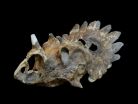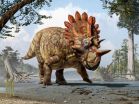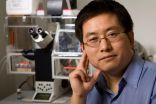(Press-News.org) About 10 years ago, Peter Hews stumbled across some bones sticking out of a cliff along the Oldman River in southeastern Alberta, Canada. Now, scientists describe in the Cell Press journal Current Biology on June 4 that those bones belonged to a nearly intact skull of a very unusual horned dinosaur--a close relative of the familiar Triceratops that had been unknown to science until now.
"The specimen comes from a geographic region of Alberta where we have not found horned dinosaurs before, so from the onset we knew it was important," says Dr. Caleb Brown of the Royal Tyrrell Museum of Palaeontology in Alberta, Canada. "However, it was not until the specimen was being slowly prepared from the rocks in the laboratory that the full anatomy was uncovered, and the bizarre suite of characters revealed. Once it was prepared it was obviously a new species, and an unexpected one at that. Many horned-dinosaur researchers who visited the museum did a double take when they first saw it in the laboratory."
Brown likes to say, only partly in jest, that the uniqueness of this specimen was so obvious that you could tell it was a new species from 100 meters away.
What made this new horned dinosaur distinctive was the size and shape of its facial horns and the shield-like frill at the back of the skull. This new species is similar in many respects to Triceratops, except that its nose horn is taller and the two horns over its eyes are "almost comically small." But the new dinosaur's most distinctive feature is that frill, including what Brown describes as a halo of large, pentagonal plates radiating outward, as well as a central spike. "The combined result looks like a crown," he says.
Brown and study co-author Donald Henderson named the new dinosaur Regaliceratops peterhewsi, a reference to its crown-like frill and to the man who first found and reported it to the museum. Despite the formal name, the scientists say they've taken to calling this dinosaur by the nickname "Hellboy."
While this new dinosaur is intriguing in its own right, Brown and Henderson say what's most significant are the implications for the evolution of dinosaurs' horned ornamentation. It's long been known that horned dinosaurs fall into one of two groups: the Chasmosaurines, with a small horn over the nose, larger horns over the eyes, and a long frill, and the Centrosaurines, characterized by a large horn over the nose, small horns over the eyes, and a short frill.
"This new species is a Chasmosaurine, but it has ornamentation more similar to Centrosaurines," Brown says. "It also comes from a time period following the extinction of the Centrosaurines."
Taken together, he says, that makes this the first example of evolutionary convergence in horned dinosaurs, meaning that these two groups independently evolved similar features.
The researchers say they hope to uncover more Regaliceratops peterhewsi specimens. They'll also be working on digital reconstructions of the skull, noting that, though intact, the fossil has been deformed after 70 million years in the Rocky Mountain foothills.
"This discovery also suggests that there are likely more horned dinosaurs out there that we just have not found yet, so we will also be looking for other new species," Brown says.
INFORMATION:
Want more info? Ask lead author Caleb Brown on Twitter @Brown_Caleb_M and the Royal Tyrrell Museum @RoyalTyrrell.
Current Biology, Brown et al.: "A New Horned Dinosaur Reveals Convergent Evolution in Cranial Ornamentation in Ceratopsidae" http://dx.doi.org/10.1016/j.cub.2015.04.041
Current Biology, published by Cell Press, is a bimonthly journal that features papers across all areas of biology. Current Biology strives to foster communication across fields of biology, both by publishing important findings of general interest and through highly accessible front matter for non-specialists. For more information please visit http://www.cell.com/current-biology. To receive media alerts for Current Biology or other Cell Press journals, contactpress@cell.com.
Infectious diseases kill more people worldwide than any other single cause, but treatment often fails because a small fraction of bacterial cells can transiently survive antibiotics and recolonize the body. A study published June 4 in Molecular Cell reveals that these so-called persisters form in response to adverse conditions through the action of a molecule called Obg, which plays an important role in all major cellular processes in multiple bacterial species. By revealing a shared genetic mechanism underlying bacterial persistence, the study paves the way for novel diagnostic ...
A team of researchers led by the University of Cambridge has described for the first time in humans how the epigenome - the suite of molecules attached to our DNA that switch our genes on and off - is comprehensively erased in early primordial germ cells prior to the generation of egg and sperm. However, the study, published today in the journal Cell, shows some regions of our DNA - including those associated with conditions such as obesity and schizophrenia - resist complete reprogramming.
Although our genetic information - the 'code of life' - is written in our DNA, ...
Our social connections and social compass define us to a large degree as human. Indeed, our tendency to act to benefit others without benefit to ourselves is regarded by some as the epitome of human nature and culture. But is it truly a quality unique to humans, or is this apparent virtue common to other species such as rats?
"We would not hesitate about helping an older person trying to cross the road", says Dr. Cristina Márquez, who conducted this study with Scott Rennie and Diana Costa from the Behavioural Neuroscience Lab, led by Dr. Marta Moita. "This type of ...
CAMBRIDGE, MA -- The process that allows our brains to learn and generate new memories also leads to degeneration as we age, according to a new study by researchers at MIT.
The finding, reported in a paper published today in the journal Cell, could ultimately help researchers develop new approaches to preventing cognitive decline in disorders such as Alzheimer's disease.
Each time we learn something new, our brain cells break their DNA, creating damage that the neurons must immediately repair, according to Li-Huei Tsai, the Picower Professor of Neuroscience and director ...
SEATTLE - Eating less late at night may help curb the concentration and alertness deficits that accompany sleep deprivation, according to results of a new study from researchers at the Perelman School of Medicine at the University of Pennsylvania that will be presented at SLEEP 2015, the 29th annual meeting of the Associated Professional Sleep Societies LLC.
"Adults consume approximately 500 additional calories during late-night hours when they are sleep restricted," said the study's senior author David F. Dinges, PhD, director of the Unit for Experimental Psychiatry ...
Medicare costs for older patients with oral cavity and pharyngeal cancers increased based on demographics, co-existing illnesses and treatment selection, according to a report published online by JAMA Otolaryngology-Head & Neck Surgery.
Many cases of oral cavity cancer and most cases of pharyngeal cancer are diagnosed at advanced stages when management of the disease is complex and treatment is aggressive and involves multiple specialists. The publicly funded Medicare program provides an opportunity for researchers to estimate the cost of care for older patients with ...
Placenta doesn't prevent postpartum depression, ease pain, boost energy or aid lactation
Celebrities spike trend, but no studies show human benefits
Unknown risks to women and babies
CHICAGO -- Celebrities such as Kourtney Kardashian blogged and raved about the benefits of their personal placenta 'vitamins' and spiked women's interest in the practice of consuming their placentas after childbirth.
But a new Northwestern Medicine review of 10 current published research studies on placentophagy did not turn up any human or animal data to support the common ...
One of the instruments that flies aboard NASA's Aqua satellite looks at tropical cyclones using infrared light. In a comparison of infrared data from June 3 and 4, images show that Hurricane Blanca had weakened and became less organized.
The Atmospheric Infrared Sounder or AIRS instrument that flies aboard NASA's Aqua satellite measured cloud top temperatures in Blanca on June 3 at 20:17 UTC (4:23 p.m. EDT) when maximum sustained winds were near 140 mph (220 kph) with higher gusts. At the time, Blanca was a category 4 hurricane on the Saffir-Simpson Hurricane Wind Scale. ...
DURHAM, NC -- There aren't any giants or midgets when it comes to the cells in your body, and now Duke University scientists think they know why.
A new study appearing June 3 in Nature shows that a cell's initial size determines how much it will grow before it splits into two.
This finding goes against recent publications suggesting cells always add the same amount of mass, with some random fluctuations, before beginning division.
"It's like students going through college," said Lingchong You, the Paul Ruffin Scarborough Associate Professor of Engineering in the ...
The most aggressive largemouth bass in the lake are also the ones most prized by anglers. These are the fish that literally 'take the bait' and put the fun into both competitive and casual sport fishing.
Then, according to the rules of catch-and-release, the captive is unhooked and tossed back to swim away without any lasting consequences. But a new UConn study says there is an impact; the evolutionary path of a species may be on the line.
In a recent paper published in the journal PLOS ONE, a team of researchers led by Jan-Michael Hessenauer and Jason Vokoun of the ...




